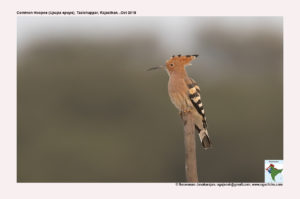
Common Hoopoe Upupa epops
Etymology:
- Upupa : Latin word for Hoopoe
- Epops : Greek word for Hoopoe
Vernacular Names : Baluchistan: Murgh-i-Suleiman, Pushtu: Lachar ghak, Sind: Katkato, Hindi: Hudhud, Kash: Satut, Hudhud, H.P: Sukdudu, Pun: Chakkiraha, Bebedukh, M.P: Khatola, Navah, Seen korka, Cachar: Dao hu dup, Mani: Songaraba, Sangairaba, Guj: Hudhud, Ghanti tankno, Mar: Hudhud, Hoopya, Ta: Chaval kuruvi, Te: Konda pitta, Kireetam pitta, Kukudu guwa, Kukudu pitta, Mal: Uppooppan, Kan: Chandramukuta, Hoopo, Sinh: Poruwa kurulla
Distribution in India: Wide spread resident, winter visitor in West and Summer visitor in North
Description: Size of 19–32 cm; nominate 46–89 g. It has a long, thin, decurved bill (5–6 cm), large crest, black-and-white rounded wings, and broad black tail with white band near base. In flight, white and black bands on inner wing, wholly black primary-coverts and black primaries. The male of nominate race is pale sandy-buff, tinged pinkish below feathers of crest are with white subterminal spots and black tips. It has white band across tips of primaries, white tips on inner primaries; bill is grey, legs are short, flesh-grey to dark grey. Both the sexes are similar, female slightly smaller and duller, throat is more whitish. The juvenile is like female, but crest and bill are shorter, and duller. The races vary mainly in size, depth of coloration and some other details. Race ceylonensis overall smaller (19–20 cm versus 21–22 cm elsewhere in Indian Subcontinent), has smaller, more rufous, crest (41–49 mm versus 49–52 mm elsewhere in Indian Subcontinent) without subterminal white, and foreparts much darker, richer buffs.
Habitat: It is found in bare or lightly vegetated ground which is easy to forage and vertical surfaces with cavities (such as trees, cliffs or even walls, nest boxes, haystacks, and abandoned burrows) for nesting
Food Habits: It eats insects, small reptiles, frogs and plant matter such as seeds and berries. It is a solitary forager which typically feeds on the ground. Sometimes it will feed in the air, where its strong and rounded wings make it fast and maneuverable, in pursuit of numerous swarming insects. More commonly its foraging style is to stride over relatively open ground and periodically pause to probe the ground with the full length of their bill. Insect larvae, pupae and mole crickets are detected by the bill and either extracted or dug out with the strong feet. Hoopoes will also feed on insects on the surface, probe into piles of leaves, and even use the bill to lever large stones and flake off bark. Larger prey items are beaten against the ground or a preferred stone to kill them and remove indigestible body parts such as wings and legs
Breeding Habits: Hoopoes are monogamous, for a single season, and territorial. The male calls frequently to advertise his ownership of the territory. Chases and fights between rival males (and sometimes females) are common and can be brutal. Birds will try to stab rivals with their bills, and individuals are occasionally blinded in fights. The nest is in a hole in a tree or wall, and has a narrow entrance. It may be unlined, or various scraps may be collected. The female alone is responsible for incubating the eggs. Clutch size is 6-7 eggs. Hoopoes have well-developed anti-predator defenses in the nest. The uropygial gland of the incubating and brooding female is quickly modified to produce a foul-smelling liquid, and the glands of nestlings do so as well. These secretions are rubbed into the plumage. The secretion, which smells like rotting meat, is thought to help deter predators, as well as deter parasites and possibly act as an antibacterial agent. The secretions stop soon before the young leave the nest. From the age of six days, nestlings can also direct streams of feces at intruders, and will hiss at them in a snake-like fashion. The young also strike with their bill or with one wing. The incubation period for the species is between 15 and 18 days, during which time the male feeds the female. Incubation begins as soon as the first egg is laid, so the chicks are born asynchronously. The chicks hatch with a covering of downy feathers. The chicks are brooded by the female for between 9 and 14 days. The female later joins the male in the task of bringing food. The young fledge in 26 to 29 days and remain with the parents for about a week more.